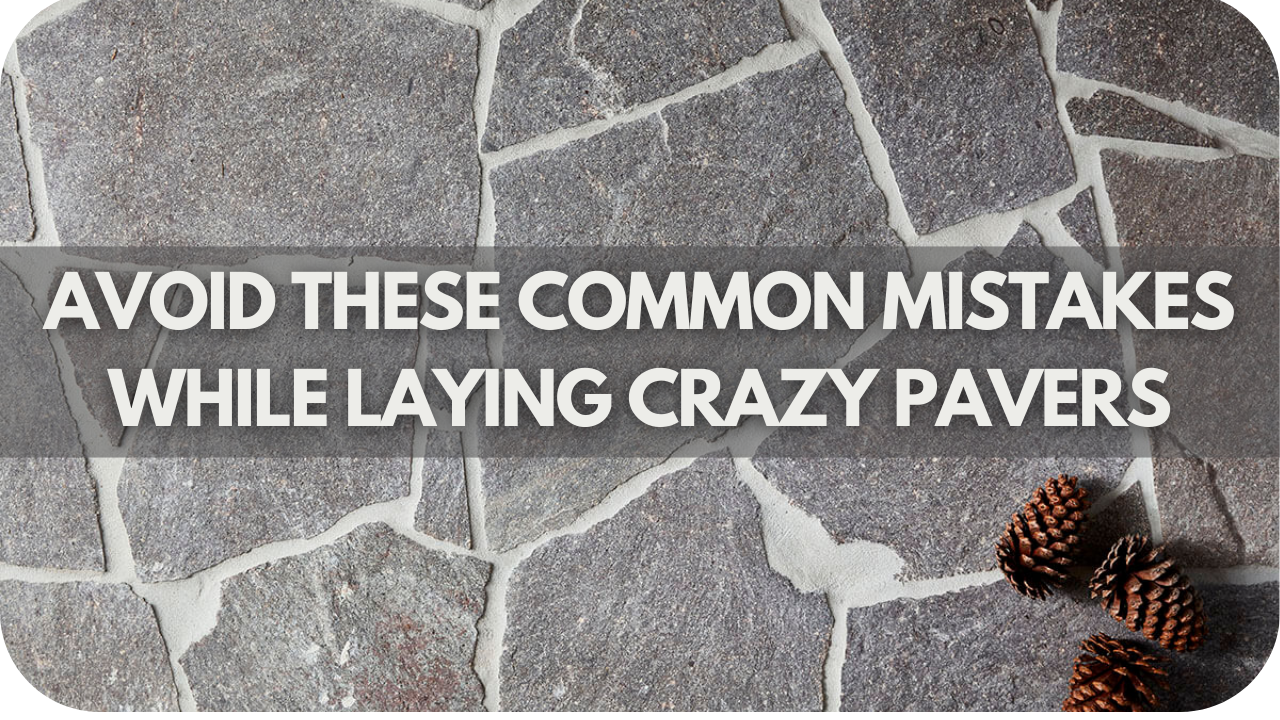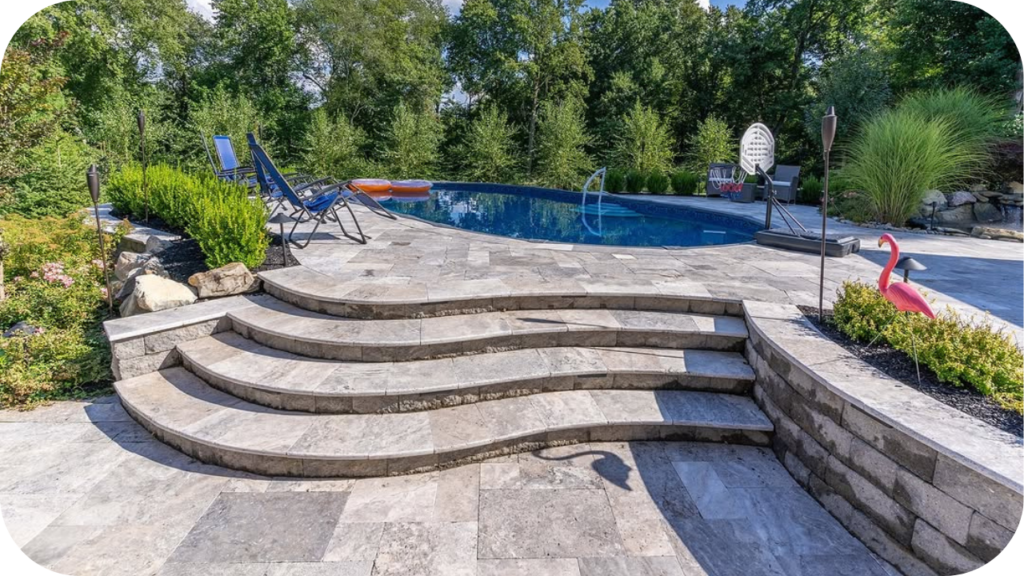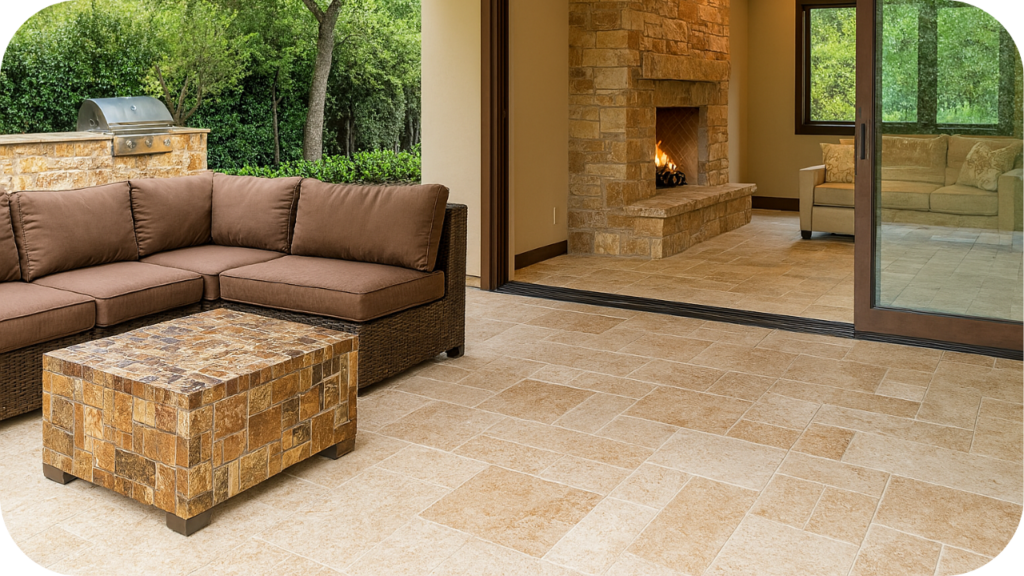
Laying crazy pavers can be challenging, with many homeowners making common mistakes.
These mistakes can lead to uneven surfaces, poor drainage, and a less-than-perfect appearance, which can cause frustration and costly repairs.
This article explains the most frequent pitfalls and provides expert tips for ensuring your crazy paver project is smooth, durable, and visually stunning.
Mistake 1: Inadequate Planning
Planning is the foundation of any successful crazy paving project, yet it’s often overlooked. Even minor mistakes can escalate without a detailed plan, leading to costly adjustments later.
Have you considered the layout and design thoroughly? Failing to do so can result in a disorganised appearance that doesn’t complement your outdoor space. A clear vision should be the first step, ensuring that all pavers’ angles, shapes, and sizes are accounted for.
Inadequate planning also impacts material usage. If you don’t accurately calculate the pavers needed, you might run out halfway through the project. If matching pavers are unavailable, this could lead to inconsistent results.
Furthermore, a proper drainage system is essential, and ignoring this during planning can prevent water from pooling and damaging the foundation. Think ahead, and remember that even though crazy paving seems random, a well-planned strategy ensures long-lasting, visually pleasing results.
Mistake 2: Poor Base Preparation
A strong foundation is key to the longevity of your crazy paving, yet many DIY enthusiasts neglect this crucial step. Your pavers will likely shift or sink over time without a properly prepared base. How can you expect pavers to stay level if the ground beneath is unstable? A stable base, typically composed of compacted gravel and sand, ensures that the surface remains even.
Another common error is ignoring the need for excavation. Digging deep enough is essential to allow for the necessary layers. The pavers won’t sit securely if the base isn’t deep enough, leading to unevenness and potential safety hazards. Moreover, proper compaction is vital. Failing to compact the base layers can cause the pavers to settle unevenly as time passes, ruining the overall look.
Drainage should also be considered during this stage. Water can pool under the pavers without a well-draining base, weakening the structure. Ensure the ground slopes slightly away from buildings or structures to prevent water damage.
Mistake 3: Incorrect Material Selection
Choosing the wrong materials can undermine the entire crazy paving project. Not all stones or pavers are suitable for every environment or use.
Have you considered the climate and foot traffic in your area? Selecting the right materials means factoring in weather resistance, durability, and aesthetic appeal. Specific stones, such as sandstone, may look stunning, but they can be prone to weathering and damage in harsh climates.
Thickness is another vital aspect to consider. If you opt for thinner pavers in high-traffic areas, they may crack under pressure. In contrast, heavier, more durable materials are ideal for areas where pavers must withstand frequent use. Additionally, colour consistency should be considered. In some cases, variations in natural stone can add character, but poor choices can lead to a mismatched or uneven look.
Remember maintenance. Some materials require sealing and regular upkeep to prevent discolouration and erosion. Always consider the long-term care of your chosen materials.
Mistake 4: Skipping Edge Restraints
Skipping edge restraints is a mistake that can compromise the entire crazy paving project. Without proper restraints, pavers are prone to shifting and spreading over time. What happens when the edges aren’t securely held in place? The pattern you’ve carefully laid out begins to lose shape, creating gaps and uneven surfaces.
Edge restraints are essential for keeping pavers in place. They provide the necessary support to prevent movement, especially in areas with heavy foot traffic or where the ground may shift. Selecting the right edge restraint type for your project is important. Options range from plastic to metal and concrete, each offering different levels of durability.
Installing restraints early on will also make the paving process easier. Neglecting this step often leads to costly repairs, as loose pavers can damage the overall structure. Additionally, edge restraints help maintain the integrity of the base and prevent the surrounding soil from creeping into the paving area. To ensure your crazy paving stands the test of time, always incorporate strong and reliable edge restraints from the start.
Mistake 5: Improper Joint Spacing
Improper joint spacing can ruin the look and durability of your crazy paving. When joints are too wide, the structure becomes weak and more prone to shifting. Have you ever noticed pavers spreading apart or becoming uneven over time? This often results from large gaps between the stones, which allows water to seep in, leading to erosion and movement.
On the other hand, if the joints are too tight, there’s no room for natural expansion and contraction. Pavers may crack or chip as they push against each other. Finding the right balance in spacing is crucial to allow proper sand or mortar to fill the joints while maintaining structural integrity. Remember, joint size will vary depending on the shape and size of your pavers, so there’s no one-size-fits-all approach.
A consistent and even gap between pavers also enhances the design’s visual appeal. By taking the time to ensure accurate joint spacing, you’ll achieve a more professional-looking finish and prolong the life of your paving project. Avoid rushing through this step; precise spacing is key to a successful result.
Mistake 6: Neglecting Drainage Considerations
Neglecting drainage considerations is a common yet critical mistake when laying crazy pavers. Poor drainage can lead to pooling water, which weakens the base and causes pavers to shift over time. Have you thought about how water will flow around your paving area? Failing to account for this can result in uneven surfaces and structural damage.
A proper drainage plan should always be in place before laying pavers. Sloping the ground slightly away from buildings ensures water flows away, preventing long-term damage to the paving and nearby structures. Without a proper slope, water can accumulate, leading to erosion beneath the pavers and eventual sinking.
In areas prone to heavy rainfall, incorporating a drainage system, such as gravel beds or drainage channels, can prevent excess water pooling. Ignoring this step may not show immediate consequences, but over time, it can ruin the look and stability of your crazy paving.
Mistake 7: Rushing the Installation
Rushing the installation process is one of the most common mistakes when laying crazy pavers. When you hurry, you often overlook crucial steps, leading to an unstable and unsightly result.
Why take shortcuts that could cost you more time and money in the long run? A well-executed paving project requires patience and precision, especially when dealing with irregularly shaped stones.
Allowing adequate time for each stage ensures a solid foundation and smooth finish. If you rush, you might fail to compact the base properly, leading to uneven pavers or sinking over time. Skipping the proper drying time for adhesives or mortar can also result in loose or shifting pavers.
It’s important to take a measured approach, adjusting and aligning each paver to create a balanced, professional appearance. Even though crazy paving may look random, achieving the desired result requires a thoughtful and systematic process.
Remember, the extra time you invest in doing it right the first time will save you from future repairs and ensure a long-lasting, beautiful paving installation.
Mistake 8: Improper Cutting and Fitting
Improper cutting and fitting can severely compromise the look and durability of your crazy paving project. Poorly cut pavers result in uneven gaps, making the entire surface appear disorganised. Have you ever wondered why some paved areas look jagged or unfinished? This is often due to hasty or inaccurate cutting that doesn’t match the required shape or size.
Using the right tools is essential for precise cuts. Pavers should be trimmed to fit snugly into the design without leaving large gaps or overhangs. Rushing through this process can lead to errors that are difficult to fix later. In contrast, careful measuring and deliberate cutting ensure each paver fits perfectly into the pattern.
It’s also important to consider the type of material you are cutting. Different stones require specific tools and techniques to achieve clean, professional cuts. A paver that isn’t cut properly not only looks out of place but can also weaken the structural integrity of the paving.
Mistake 9: Inadequate Compaction
Inadequate compaction can significantly impact the durability and appearance of your crazy paving. Without a well-compacted base, pavers like granite, limestone, and bluestone will shift and become uneven over time.
Have you considered how these heavy, natural stones require a stable foundation to maintain their beauty and structure? Failing to compact the base adequately can lead to air pockets that weaken the ground.
Granite, a dense and durable stone, demands a firm base to prevent sinking. Likewise, limestone and bluestone—popular for crazy paving—require solid compaction to avoid uneven surfaces and movement. The process involves compacting each base material layer, ensuring no gaps are left. Skipping or rushing through this essential step may cause your pavers to shift under foot traffic or weather pressure.
Using the right tools, such as a vibrating plate compactor, ensures that each layer is properly compacted. Compacting the base thoroughly, especially when using heavy stones like granite, limestone, or bluestone, creates a long-lasting and visually appealing crazy paving surface. By investing effort in this critical stage, you’ll avoid future repairs.
Mistake 10: Neglecting Sealing and Maintenance
Neglecting sealing and maintenance is a mistake that can drastically shorten the lifespan of your crazy paving. Natural stones like granite, limestone, and bluestone are more vulnerable to staining, moisture damage, and weathering without sealing.
Have you considered how unprotected pavers can lose their visual appeal over time? Sealing provides a protective layer, preventing water and dirt from penetrating the surface.
Different stones require different types of sealants, so it’s important to choose the right one for your paving material. Regular maintenance is just as crucial. If pavers are not cleaned periodically, dirt and debris can build up, making the surface dull and unattractive.
In some cases, neglecting sealing can lead to cracks as moisture seeps in and freezes during colder months. Sealing also helps enhance the stones’ natural colours, keeping your paving fresh and vibrant.
Maintenance, including regular cleaning and resealing when necessary, ensures that your crazy paving continues to stand the test of time.
Conclusion
In conclusion, to ensure a successful crazy paving installation, avoid common mistakes like neglecting edge restraints, improper joint spacing, rushing the process, and inadequate compaction. Prioritise precision, proper drainage, sealing, and ongoing maintenance.
Following these best practices will create a durable, visually appealing outdoor space. Take the time to plan meticulously and execute diligently for lasting results.
More To Explore

10 Advantages of Travertine Tiles for Outdoor Landscaping
Travertine tiles remain a popular choice for outdoor landscaping thanks to their balance of natural elegance, durability, and adaptability. Formed over centuries, each tile carries

8 Design Ideas with Outdoor Travertine Tile
Travertine tiles have long been a favourite for outdoor paving, prized for their natural elegance and adaptability across different design styles. Formed over centuries, each


